As long ago as 1886 petroleum was obtained from the Devonian-aged Dundee limestone--in the wells near Port Huron, a thick oil which was produced for use in manufacture of lubricants until the property on which the wells were drilled became more valuable as a building property. But in the 1920's petroleum and natural gas were found in the buried Traverse rocks which overlie the Dundee--the same rocks that come to the surface in an arc and are quarried from Alpena to Little Traverse Bay, then slope southward under the peninsula to its center, but then rise again towards the southern boundary of the State. Wells were feverishly drilled to the oil pools underlying Saginaw and Muskegon, and because people were so eager to get rich with the black gold from these pools, the fields were over-drilled, the natural gas allowed to escape, the oil taken out too quickly so that pressure on the water surrounding the pools was released, water seeped in, drowned the polls and destroyed the oil and gas wells.
Much organic matter was buried in the lime and clay muds on the floors of the old seas when the animals living in them died, and remained when the muds solidified into shales and limestones. The organic matter was eventually distilled to petroleum and natural gas which collected under the high tops of the main rock folds, as the hydrocarbons are lighter than water. When the gas and oil are taken out of the folds--oil people call them "structures"--water takes their place. If the gas and oil is removed too rapidly, pressure on the water is released--it can move faster than the oil and drives in and drowns the oil pool. This is just what happened in Saginaw and Muskegon.
Having found profitable quantities of oil in the Traverse limestone, exploration went deeper and even more oil was discovered in the Dundee limestone which is separated from the Traverse by a 40-80 foot bed of Bell shale--names from the old town of Bell, Presque Isle County, where a quarry producing the shale for cement was once operated. Deeper drilling in the Devonian found another reservoir of oil in the Detroit River formation. Salt brine is produced form the formation at Ludington and Manistee but at the top of folds in the formation and in porous buried coral reefs several oil fields have been developed. Was the organic matter in the black Mississippian shale, the Antrim overlying the Traverse, the source of the Traverse oil? Probably not (though much natural gas is found in the Antrim), but the black Antrim, green Ellsworth, and the blue Coldwater shales are very useful in the manufacture of cement, brick and tile, and quarries are worked in them in Alpena, Charlevoix, Antrim and Branch counties.
The end of Mississippian was a time of shallowing seas in Michigan, and of warm and often arid climates, such that the sea deposits were limestones, shales, and gypsum.. Along the shores of the old seas waves and currents heaped piles of sand just to the water level, sand bars developed. Today in drilling for oil we find those old bars and discover that in many of them natural gas has collected.
The swamp forests of the Pennsylvanian stored other forms of usable wealth as well. The sands at the bottom of the swamp, now hardened into the Parma sandstone, are a prominent reservoir for fresh water in central Michigan counties; in a small area natural gas has been obtained from it.
Thus, long ago Nature stored in Michigan’s coral seas much wealth. The wealth in limestone and salt is immeasurable, but the wealth in petroleum and gas can be exhausted or destroyed very rapidly. To a large extent, northern Michigan’s "tranquility" was shattered in the early 1970s with the discovery of oil and natural gas. In 1973 Shell Oil contracted with a Texas-based engineering firm to build a $20 million gas processing plant in Kalkaska County. Rapid growth occurred. At that time, Kalkaska County received national recognition as one of the fastest growing rural counties in the nation. By 1982 the county’s population had reached nearly 11,000. Between 1,500 and 1,800 people were employed in petroleum-related services, which provided 30% of all the county’s earnings. Kalkaska soon experienced fast food restaurants, four new banks, a sixfold increase in county revenues and a fivefold increase in the county’s sheriff patrol. In 1984, Kalkaska’s over 200 oil and gas wells make it a leader in tax revenues generated from petroleum production.
The petroleum boom has not been without its drawbacks. New roads to oil sites scar the forests. Putrid, sulfurous odors assail passersby. Brine pollution has affected some the county’s water supply. Brine (salt water sometimes mixed with a small amount of chemicals) is both a by-product and a raw material in oil production. Careless use of brine can contaminate water supplies. In 1980, Kalkaska petroleum wells produced 77 million gallons of brine. A small amount of brine is sprayed on the county’s unpaved roads to control road dust, but most of it is pumped back into the ground. In some instances, brine disposal in violation of pollution regulations has contaminated water wells in the county. However, according DNR officials, the recent adoption of a comprehensive brine management plan has greatly reduced the possibilities of groundwater contamination.
Though Kalkaska’s growth has subsided during the past several years, its estimated oil reserves should last for many more years. Kalkaska may enter the 21st century much as it did the 20th century---reaping the riches of its natural resources, only this time it will be hydrocarbons, not wood.
Despite the abundance of natural gas production in Michigan, the residents of our state still use much more gas than we produce.
Note that the chart below does NOT show the major gas finds in the Antrim shale, since this source did not begin to be a major producer until the 1980's. Oil and gas revenues do a lot to fuel the state’s economy, not only directly but by attracting industry to the state--industry that either assists in the drilling and dissemination of oil and gas, or in its utilization. Crude oil and gas revenues, however, continue to decline in the state (data which may not be reflected on these charts, as the charts are sometimes older).
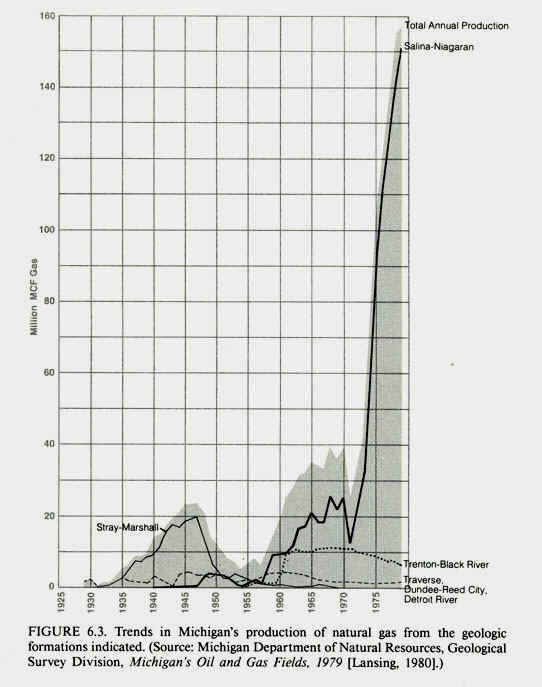
The late surge of drilling for Antrim shale gas was largely spurred on by a tax incentive. The gas reserves were known to exist for some time prior to their rapid exploitation in the 1980's and 1990's.
When the hydrocarbons in oil and gas wells are extracted, using pumps as shown below, both oil and natural gas (methane, among other gases) come up and out of the well together--mixed.
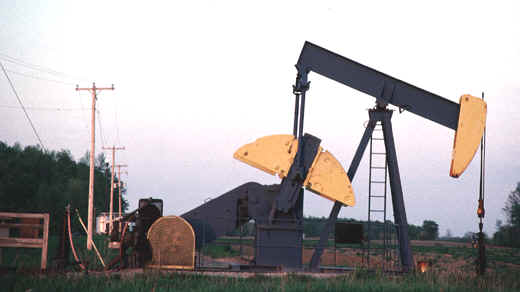
Source: Photograph by Randy Schaetzl, Professor of Geography - Michigan
State University
In many cases the two can be separated, with the oil
being stored in tanks near the wellhead and gas transported out in a
pipeline. The pipeline system of oil and gas distribution is shown
below.
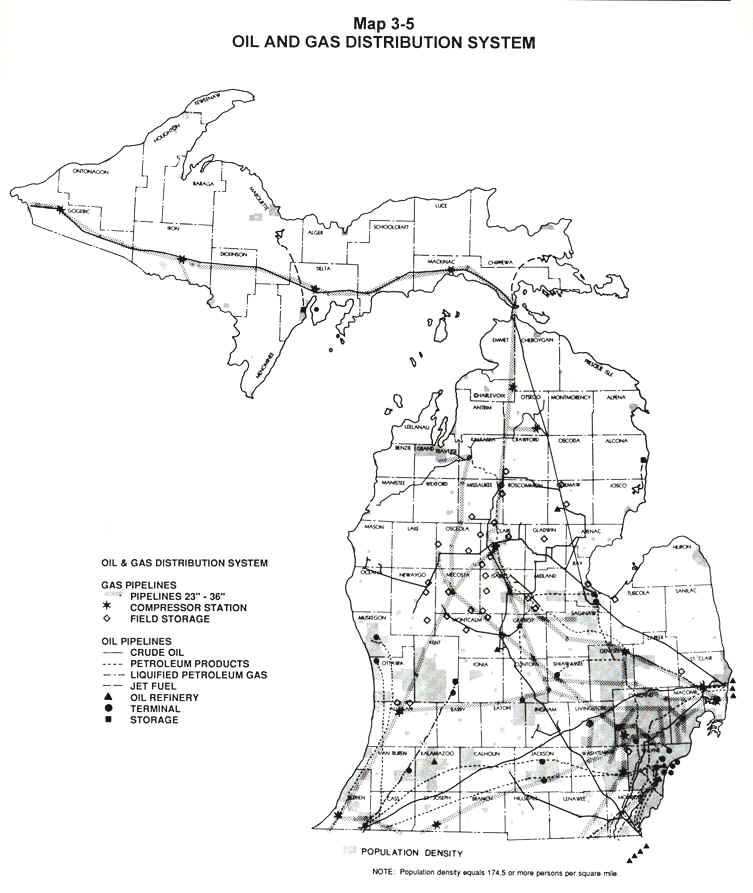
Source: Unknown
However, in some smaller and older wells, or in those not near
pipelines, the gas is not recovered; instead it is burned off, or
"flared". The images below show such a flare--perhaps you have seen
similar sites around the state or nation?
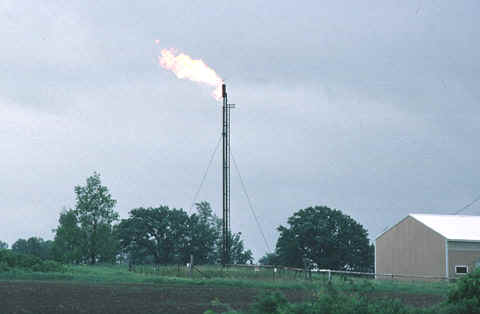
Source: Photograph by Randy Schaetzl, Professor of Geography - Michigan
State University
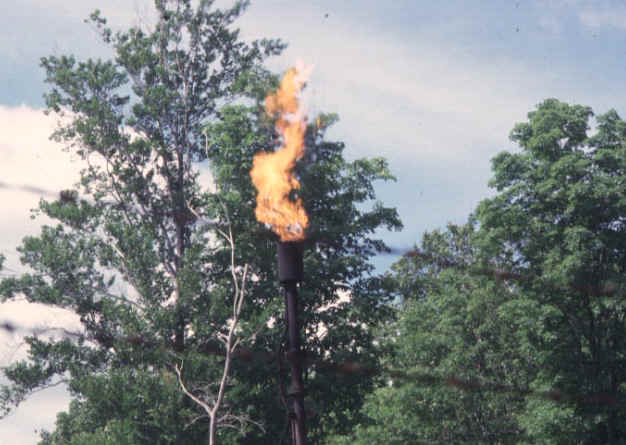
Source: Photograph by Randy Schaetzl, Professor of Geography - Michigan State University
On many occasions, wells are drilled in distinct rows, along areas
where the oil and gas traps are linear. Look for these when you
drive through a hydrocarbon-rich area!
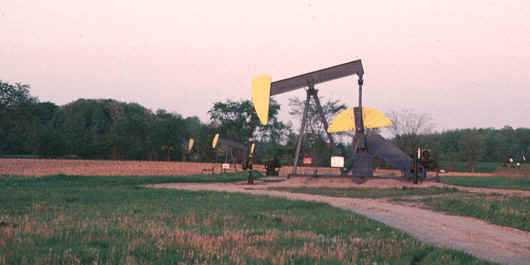
Source: Photograph by Randy Schaetzl, Professor of Geography - Michigan State University
Distribution of oil and
gas
Today, many of the gas wells in the state have been
drilled, and are now silently producing gas, sent to its destination via
pipeline. Pipeline is the preferred way to transport the oil and gas
to the refineries. The gas well shown below, isolated within a dense
stand of woods, is typical of the thousands of gas wells in
Michigan.
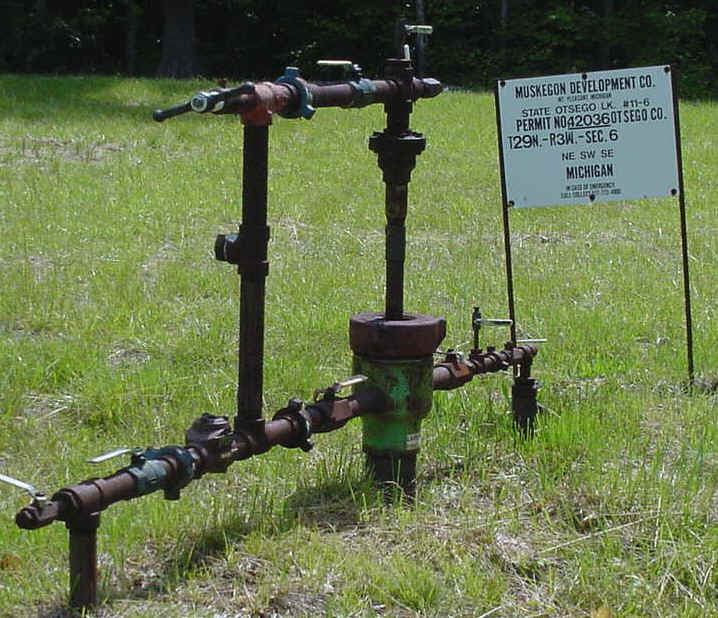
Source: Photograph by Randy Schaetzl, Professor of Geography - Michigan State University
Michigan has many thousands of miles of underground gas and oil
pipelines, like the one shown below.

Source: Photograph by Randy Schaetzl, Professor of Geography - Michigan
State University
Some of the images and text on this page
were taken from various issues of Michigan
History magazine and have been
paraphrased from C.M. Davis’ Readings in the Geography
of Michigan (1964).
This material has been compiled for educational use only, and may not be reproduced without permission. One copy may be printed for personal use. Please contact Randall Schaetzl (soils@msu.edu) for more information or permissions.